2 Overview of Oracle Database Appliance
This chapter describes Oracle Database Appliance features. There are four versions of Oracle Database Appliance and this document covers all four versions:
-
Oracle Database Appliance X5-2
-
Oracle Database Appliance X4-2
-
Oracle Database Appliance X3-2
-
Oracle Database Appliance original version (also referred to as "version 1" or "V1")
For information about Oracle Database Appliance features:
Supported Components and Capabilities
The following table describes the components and capabilities of Oracle Database Appliance.
| Component | ODA (Original Version) | ODA X3-2 | ODA X4-2 | ODA X5-2 |
|---|---|---|---|---|
|
Server node |
Two server nodes per chassis. Each server node operates independently from the other server node. The lower server node is SN0; the upper server node is SN1. |
Two server nodes per chassis. Each server node operates independently from the other server node. The lower server node is node 0 (SN0). The upper server node is node 1 (SN1). |
Two server nodes per chassis. Each server node operates independently from the other server node. The lower server node is node 0 (SN0). The upper server node is node 1 (SN1). |
Two server nodes per chassis. Each server node operates independently from the other server node. The lower server node is node 0 (SN0). The upper server node is node 1 (SN1). |
|
CPUs |
Two 6-core 3.06 GHz Intel Xeon® X5675 processors per server node. |
Two 8-core 2.9 GHz Intel Xeon® E5-2690 processors per server node. |
Two 12-core 2.7 GHz Intel Xeon® E5-2697 v2 processors per server node. |
Two 18-core 2.3 GHz Intel Xeon® E5-2699 v3 processors per server node. |
|
Memory |
96 GB per server node. Six 8 GB low-voltage DDR3 RDIMM (single or dual rank) at 1333-MHz per
server node.
Note - Quad-rank DIMMs are not supported. |
256 GB per server node. Sixteen 16 GB low-voltage DDR3 RDIMM at 1600 MHz per server node. |
256 GB per server node. Sixteen 16 GB low-voltage DDR3 RDIMM at 1600 MHz per server node. |
256 GB per server node. Eight 32 GB low-voltage DDR4 LRDIMM at 2133 MHz per server
node.
Note - Optional memory expansion to 512 GB or 768 GB. Both server nodes must have the same amount of memory. See Optional Component Installation. |
|
Storage devices |
Each server node includes:
|
Each server node includes:
The storage shelf and the optional storage expansion shelf each include:
|
Each server node includes:
The storage shelf and the optional storage expansion shelf each include:
|
Each server node includes:
The storage shelf and the optional storage expansion shelf each include:
|
|
USB 2.0 ports |
Two rear and one internal for each server node. |
Six total (two front, two rear and two internal) per server node. |
Six total (two front, two rear and two internal) per server node. |
Six total (two front, two rear and two internal) per server node. |
|
PCI Express (PCIe) I/O slots |
Three external low-profile PCIe Gen-2 slots (x8) for each server node:
One internal low-profile PCIe Gen-2 slot (x8) with a Dual-port Internal 6Gb/s SAS2 host bus adapter |
Three external and one internal low-profile PCIe Gen-3 slots for each server node. They contain:
|
Three external and one internal low-profile PCIe Gen-3 slots for each server node. They contain:
|
Three external and one internal low-profile PCIe Gen-3 slots for each server node. They contain:
|
|
Cluster device |
One integrated cluster device with node-to-node connections is provided on each server node. Each integrated cluster device provides two internal 1 GbE network interface ports and two internal dual-port UART ports. |
One integrated cluster device with node-to-node interconnection is provided on each server node through two 10 GbE network interface ports with RJ-45 connections. |
One integrated cluster device with node-to-node interconnection is provided on each server node through two 10 GbE network interface ports with dual-rate SFP+ connections. Alternately, you have the option of creating the node-to-node interconnection using two of
each server node's four 10 GbE network interface ports with RJ-45 connections. Refer to the
Oracle Database Appliance Getting Started Guide for more information.
|
One integrated cluster device with node-to-node interconnection is provided on each server node through two InfiBand ports with QSFP+ connections. Alternately, you have the option of creating the node-to-node interconnection using two of
each server node's four 10 GbE network interface ports with RJ-45 connections. Refer to the
Oracle Database Appliance Getting Started Guide for more information.
|
|
SAS ports |
N/A |
Two internal SAS2 and four external SAS2 ports on each server node. Six SAS2 ports on the storage shelf. Six SAS2 ports on the storage expansion shelf. |
Two internal SAS2 and four external SAS2 ports on each server node. Six SAS2 ports on the storage shelf. Six SAS2 ports on the storage expansion shelf. |
Two internal SAS3 and four external SAS3 ports on each server node. Six SAS2 ports on the storage shelf. Six SAS2 ports on the storage expansion shelf. |
|
Onboard Ethernet ports |
Two 1 GbE network interface ports with RJ-45 connectors located on the rear panel of each server node. |
Four 10 GbE network interface ports with RJ-45 connectors located on the back of each server node. |
Four 10 GbE network interface ports with RJ-45 connectors located on the back of each server node. |
Four 10 GbE network interface ports with RJ-45 connectors located on the back of each server
node.
Note - Optionally, you can purchase the Sun Dual 10GbE SFP+ PCIe 2.0 Low Profile Adapter as a replacement for the standard InfiniBand adapter if an Ethernet fiber connection to the data center or public network is required. See Optional Component Installation. |
|
Network management (NET MGT) port |
One 10/100Base-T network interface port with RJ-45 connector dedicated to the service processor (SP) on each server node rear panel. |
One 10/100Base-T network interface port with RJ-45 connector dedicated to the service processor (SP) on each server node rear panel. |
One 10/100Base-T network interface port with RJ-45 connector dedicated to the service processor (SP) on each server node rear panel. |
One 10/100/1000Base-T network interface port with RJ-45 connector dedicated to the service processor (SP) on each server node rear panel. |
|
Serial management (SER MGT) port |
One RS-232 RJ-45 serial port on each server node rear panel. |
One RS-232 RJ-45 serial port on each server node rear panel. |
One RS-232 RJ-45 serial port on each server node rear panel. |
One RS-232 RJ-45 serial port on each server node rear panel. |
|
VGA port |
One high-density HD-15 video port on each server node rear panel. |
One high-density HD-15 video port on each server node rear panel. |
One high-density HD-15 video port on each server node rear panel. |
One high-density HD-15 video port on each server node rear panel. |
|
Service Processor (SP) |
Each server node has a service processor with the following features:
|
Each server node has a service processor with the following features:
|
Each server node has a service processor with the following features:
|
Each server node has a service processor with the following features:
|
|
Power supplies |
Two hot-swappable power supplies per chassis. |
Two hot-swappable power supplies per server node and per storage shelf. |
Two hot-swappable power supplies per server node and per storage shelf. |
Two hot-swappable power supplies per server node and per storage shelf. |
|
Cooling fans |
Two redundant hot-swappable fan modules per server node. |
Four 40-mm, hot-swappable fan modules per server node for chassis cooling. Each fan module contains two counter-rotating fan pairs (four rotors total). Each power supply (server node and storage shelf) has its own cooling fans. |
Four 40-mm, hot-swappable fan modules per server node for chassis cooling. Each fan module contains two counter-rotating fan pairs (four rotors total). Each power supply (server node and storage shelf) has its own cooling fans. |
Four 40-mm, hot-swappable fan modules per server node for chassis cooling. Each fan module contains two counter-rotating fan pairs (four rotors total). Each power supply (server node and storage shelf) has its own cooling fans. |
|
Operating system |
Oracle Linux. |
Oracle Linux. |
Oracle Linux. |
Oracle Linux. |
|
Management software |
Oracle Integrated Lights Out Manager (ILOM) 3.0. |
Oracle Integrated Lights Out Manager (ILOM) 3.1. |
Oracle Integrated Lights Out Manager (ILOM) 3.1. |
Oracle Integrated Lights Out Manager (ILOM) 3.2.X. |
Oracle Database Appliance X5-2 Front and Back Panels
This section describes Oracle Database Appliance X5-2 front and back panels. If you have Oracle Database Appliance X3-2 or Oracle Database Appliance X4-2, see Oracle Database Appliance X3-2/X4-2 Front and Back Panels. If you have Oracle Database Appliance (original version), see Oracle Database Appliance (Original Version) Front and Back Panels.
Oracle Database Appliance X5-2 Front Panel
Oracle Database Appliance X5-2 includes two server nodes (two Oracle Server X5-2's) and an Oracle DE2–24C storage shelf. The entire unit occupies 6RU. The optional storage expansion shelf requires an additional 4RU, increasing the total to 10RU.
The following figure shows the front of Oracle Database Appliance X5-2 with an optional storage expansion shelf.

| Callout | Description |
|---|---|
|
1 |
Server node 1 |
|
2 |
Server node 0 |
|
3 |
Storage shelf (DE2-24C) |
|
4 |
Optional storage expansion shelf (DE2-24C) |
Server Node Front Panel Features
The following figure shows the components on the front panel of an ODA X5-2 server node.
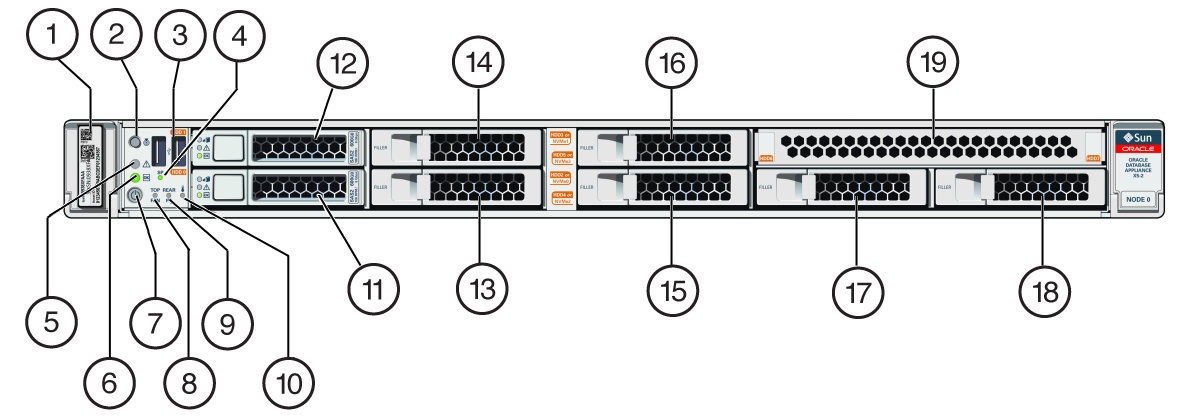
| Callout | Description | Callout | Description |
|---|---|---|---|
|
1 |
Product Serial Number (PSN) label and Radio Frequency Identification (RFID) tag |
8 |
Fan Fault LED: amber |
|
2 |
Locate LED/button: white |
9 |
Power Supply (PS) Fault LED: amber |
|
3 |
USB 2.0 connectors (2) |
10 |
System Over Temperature Warning LED: amber |
|
4 |
SP OK LED: green |
11 |
HDD 0 |
|
5 |
Service Required LED: amber |
12 |
HDD 1 |
|
6 |
Power/OK LED: green |
13 - 18 |
HDD filler |
|
7 |
Power button |
19 |
DVD filler |
Note:
When contacting Oracle Support Services, use the Top Level Identifier (TLI) instead of the serial number. You can find the TLI by looking at the top of either server node or on the top of the storage shelf. For details, see Technical Support.Storage Shelf Front Panel Features
The following figure shows the ODA X5-2 storage shelf front panel features.
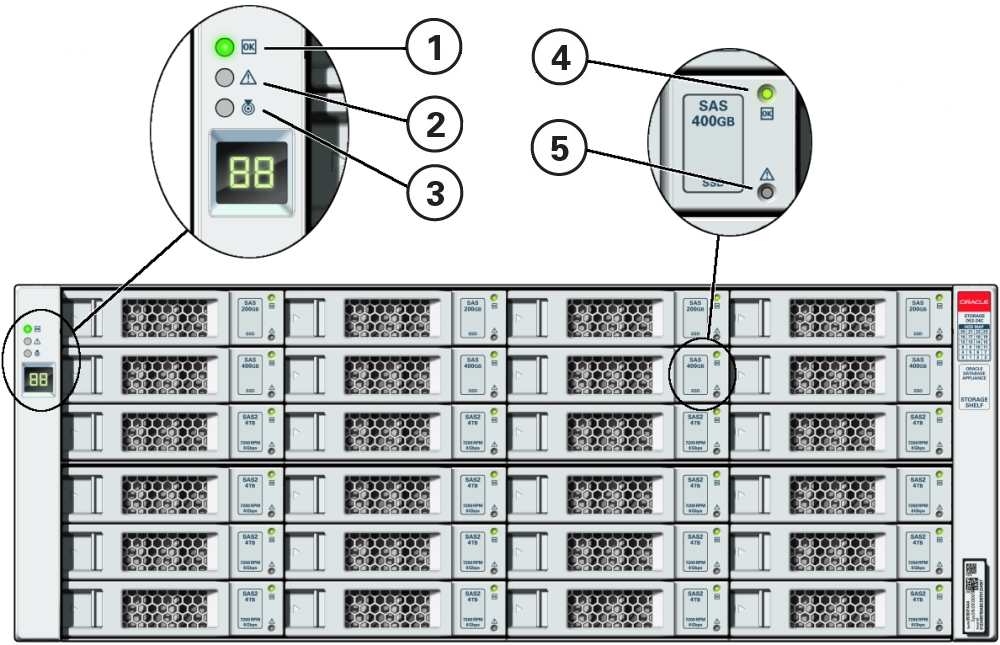
| Callout | Description |
|---|---|
|
1 |
System power indicator |
|
2 |
Module fault indicator |
|
3 |
Locate indicator |
|
4 |
Drive power/activity indicator |
|
5 |
Drive fault indicator |
Oracle Database Appliance X5-2 Back Panel
This section describes the back panel features for Oracle Database Appliance X5-2. The following figure shows the Oracle Database Appliance X5-2.
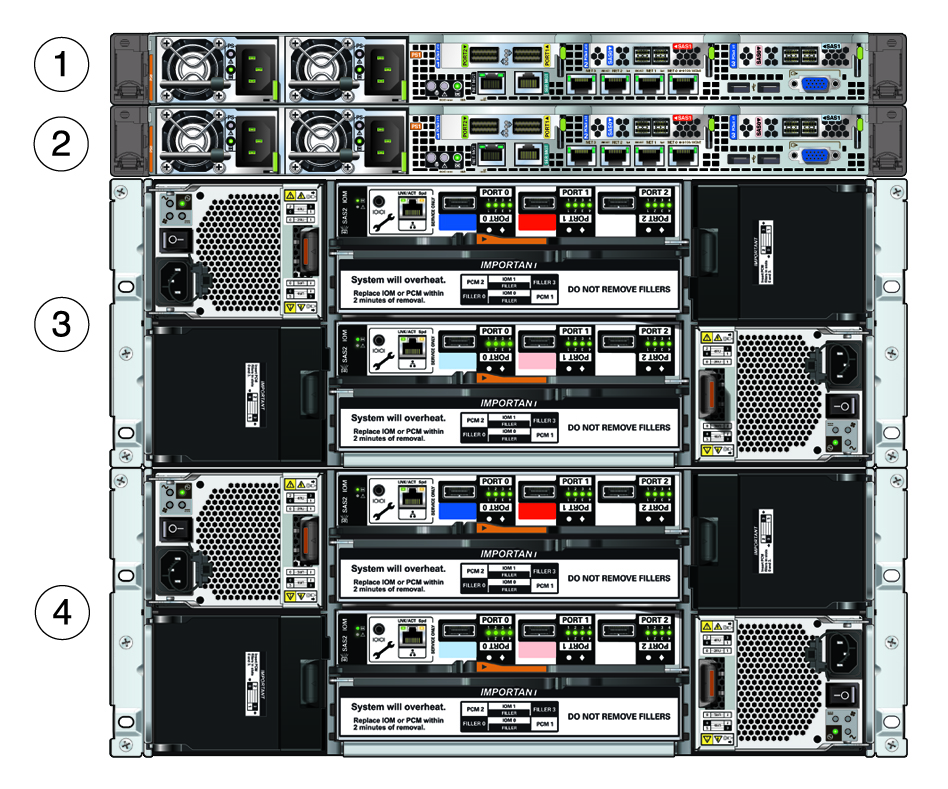
| Callout | Description |
|---|---|
|
1 |
Server node 1 |
|
2 |
Server node 0 |
|
3 |
Storage shelf (DE2-24C) |
|
4 |
Optional storage expansion shelf (DE2-24C) |
Server Node Back Panel Features
The following figure shows the components on the ODA X5-2 server node back panel.

| Callout | Description | Callout | Description |
|---|---|---|---|
|
1 |
Power Supply (PS) 0 with fan module |
9 |
NET MGT port. Service processor 10/100/1000Base-T network interface port with RJ-45 connector used to connect to Oracle Integrated Lights Out Manager (ILOM)
Caution -
The management ports are intended for use by service engineers only.
|
|
2 |
Power Supply (PS) 0 status indicators: Service Required LED: amber, AC OK LED: green |
10 |
SER MGT port. Service processor RJ-45 serial port used to connect to Oracle ILOM
Caution -
The management ports are intended for use by service engineers only.
|
|
3 |
Power Supply (PS) 1 with fan module |
11 |
10 GbE network interface port with RJ-45 connector |
|
4 |
Power Supply (PS) 1 status indicators: Service Required LED: amber, AC OK LED: green |
12 |
10 GbE network interface port with RJ-45 connector |
|
5 |
System status indicators: Locate LED: white, Service Required LED: amber, Power/OK LED: green |
13 |
10 GbE network interface port with RJ-45 connector |
|
6 |
PCIe card slot 1. Provides two InfiBand network interface ports with QSFP+ connections for a private cluster interconnect between server nodes. Alternately, you have the option of creating the node-to-node interconnection using two of
each server node's four 10 GbE network interface ports with RJ-45 connections. Refer to the
Oracle Database Appliance Getting Started Guide for more information.
|
14 |
10 GbE network interface port with RJ-45 connector |
|
7 |
PCIe card slot 2. Provides two SAS3 connectors used to connect the servers to the storage shelf and the storage expansion shelf. |
15 |
USB 2.0 connectors (2) |
|
8 |
PCIe card slot 3. Provides two SAS3 connectors used to connect the servers to the storage shelf and the storage expansion shelf. |
16 |
DB-15 video connector |
Storage Shelf Back Panel Features
The following figure shows the ODA X5-2 storage shelf back panel features.
Caution:
The network ports on the storage shelf are intended for use by service engineers only.
| Callout | Description |
|---|---|
|
1 |
AC power fail indicator |
|
2 |
Power supply status indicator |
|
3 |
Fan fail indicator |
|
4 |
DC power fail indicator |
|
5 |
Power Supply with Fan Module 2 |
|
6 |
SAS I/O module 1 |
|
7 |
SAS I/O module 0 |
|
8 |
Power Supply with Fan Module 1 |
Oracle Database Appliance X3-2/X4-2 Front and Back Panels
This section describes Oracle Database Appliance X3-2/X4-2 front and back panels. If you have Oracle Database Appliance X5-2, see Oracle Database Appliance X5-2 Front and Back Panels. If you have Oracle Database Appliance (original version), see Oracle Database Appliance (Original Version) Front and Back Panels.
Oracle Database Appliance X3-2/X4-2 Front Panel
Oracle Database Appliance X3-2/X4-2 includes two server nodes (either two Sun Server X3-2's, or two Sun Server X4-2's) and an Oracle DE2–24P storage shelf. The entire unit occupies 4RU. The optional DE2-24P storage expansion shelf requires an additional 2RU, increasing the total to 6RU.
The following figure shows the front of Oracle Database Appliance X3-2 with an optional storage expansion shelf. Except for product labeling, Oracle Database Appliance X4-2 is identical in appearance.
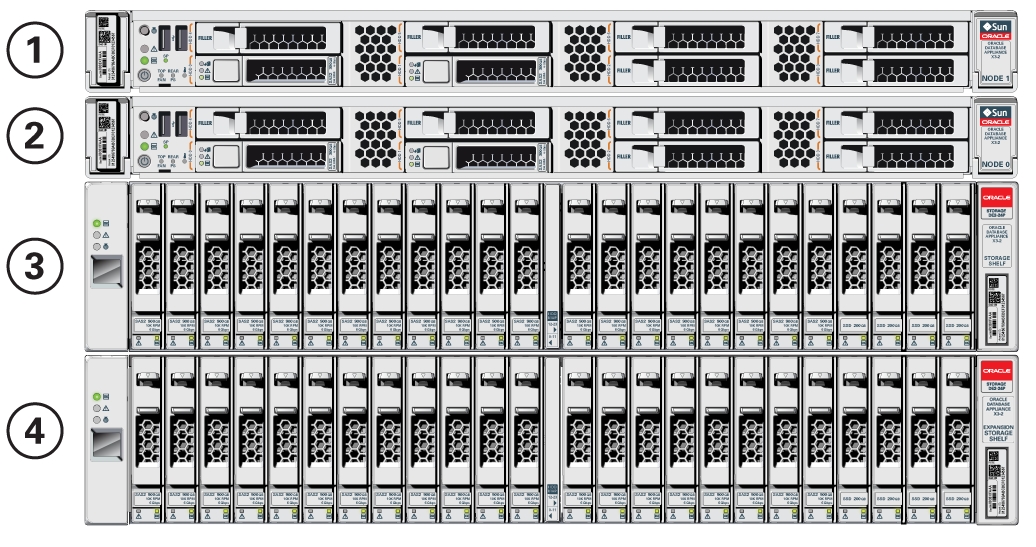
| Callout | Description |
|---|---|
|
1 |
Server node 1 |
|
2 |
Server node 0 |
|
3 |
Storage shelf (DE2-24P) |
|
4 |
Optional storage expansion shelf (DE2-24P) |
Server Node Front Panel Features
The following figure shows the components on the front panel of an ODA X3-2/X4-2 server node.
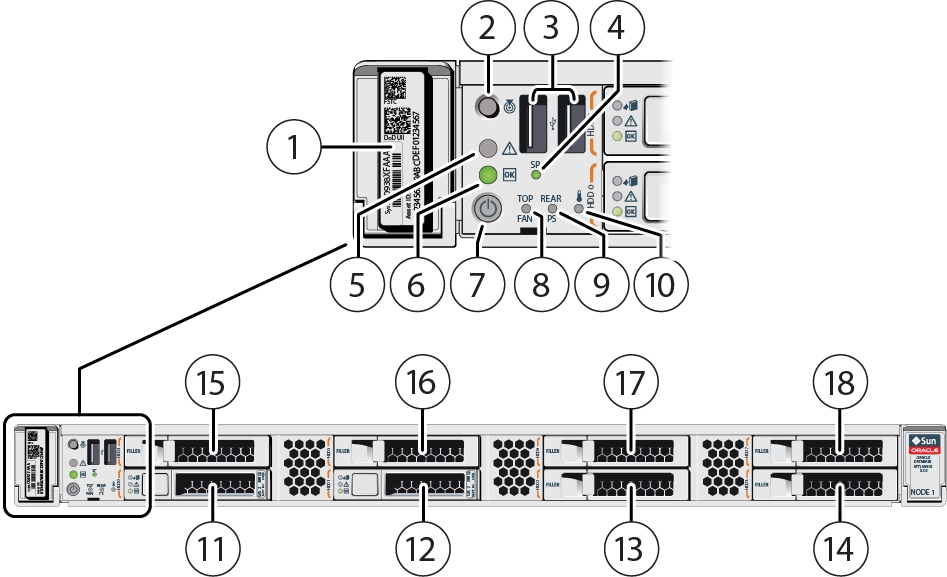
| Callout | Description | Callout | Description |
|---|---|---|---|
|
1 |
Product Serial Number (PSN) label and Radio Frequency Identification (RFID) tag |
10 |
System Over Temperature Warning LED: amber |
|
2 |
Locate LED/button: white |
11 |
HDD 0 |
|
3 |
USB 2.0 connectors (2) |
12 |
HDD 1 |
|
4 |
SP OK LED: green |
13 |
HDD filler |
|
5 |
Service Required LED: amber |
14 |
HDD filler |
|
6 |
Power/OK LED: green |
15 |
HDD filler |
|
7 |
Power button |
16 |
HDD filler |
|
8 |
Fan Fault LED: amber |
17 |
HDD filler |
|
9 |
Power Supply (PS) Fault LED: amber |
18 |
HDD filler |
Note:
When contacting Oracle Support Services, use the Top Level Identifier (TLI) instead of the serial number. You can find the TLI by looking at the top of either server node or on the top of the storage shelf. For details, see Technical Support.Storage Shelf Front Panel Features
The following figure shows the ODA X3-2/X4-2 storage shelf front panel features.
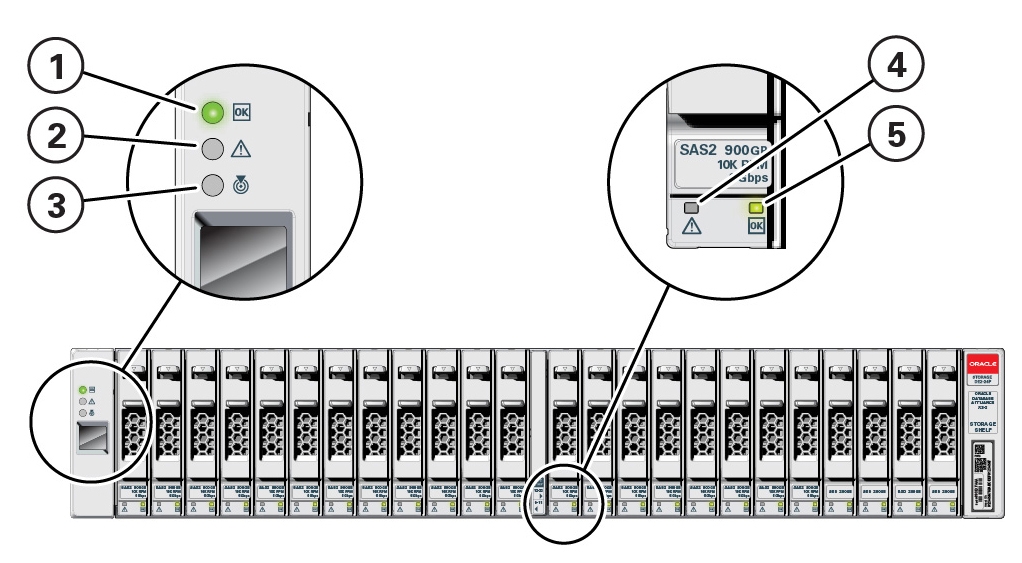
| Callout | Description |
|---|---|
|
1 |
System power indicator |
|
2 |
Module fault indicator |
|
3 |
Locate indicator |
|
4 |
Drive fault indicator |
|
5 |
Drive power/activity indicator |
Oracle Database Appliance X3-2/X4-2 Back Panel
This section describes the back panel features for Oracle Database Appliance X3-2/X4-2. The following figure shows the Oracle Database Appliance X4-2. The Oracle Database Appliance X3-2 and Oracle Database Appliance X4-2 are identical except for the network card in PCIe slot 1 (see Server Node Back Panel Features).

| Callout | Description |
|---|---|
|
1 |
Server node 1 |
|
2 |
Server node 0 |
|
3 |
Storage shelf (DE2-24P) |
|
4 |
Optional storage expansion shelf (DE2-24P) |
Server Node Back Panel Features
The following figure shows the components on the server node back panel.
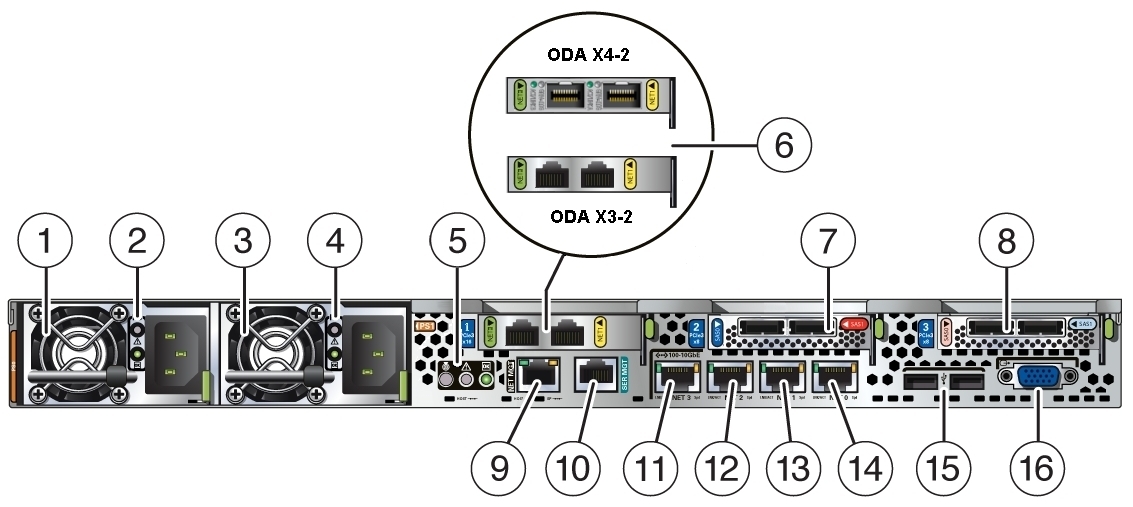
| Callout | Description | Callout | Description |
|---|---|---|---|
|
1 |
Power Supply (PS) 0 with fan module |
9 |
NET MGT port. Service processor 10/100BASE-T network interface port with RJ-45 connector used to connect to Oracle Integrated Lights Out Manager (ILOM)
Caution -
The management ports are intended for use by service engineers only.
|
|
2 |
Power Supply (PS) 0 status indicators: Service Required LED: amber, AC OK LED: green |
10 |
SER MGT port. Service processor RJ-45 serial port used to connect to Oracle ILOM
Caution -
The management ports are intended for use by service engineers only.
|
|
3 |
Power Supply (PS) 1 with fan module |
11 |
10 GbE network interface port with RJ-45 connector |
|
4 |
Power Supply (PS) 1 status indicators: Service Required LED: amber, AC OK LED: green |
12 |
10 GbE network interface port with RJ-45 connector |
|
5 |
System status indicators: Locate LED: white, Service Required LED: amber, Power/OK LED: green |
13 |
10 GbE network interface port with RJ-45 connector |
|
6 |
ODA X4-2: PCIe card slot 1. Provides two 10 GbE dual-rate
SFP+ ports for a private cluster interconnect between server
nodes.
Alternately, you have the option of creating the node-to-node interconnection using two of
each server node's four 10 GbE network interface ports with RJ-45 connections. Refer to the
Oracle Database Appliance Getting Started Guide for more information.
ODA X3-2: PCIe card slot 1. Provides two 10 GbE network
interface ports with RJ-45 connectors for a private cluster interconnect between server
nodes.
|
14 |
10 GbE network interface port with RJ-45 connector |
|
7 |
PCIe card slot 2. Provides two SAS2 connectors used to connect the servers to the storage shelf and the storage expansion shelf. |
15 |
USB 2.0 connectors (2) |
|
8 |
PCIe card slot 3. Provides two SAS2 connectors used to connect the servers to the storage shelf and the storage expansion shelf. |
16 |
DB-15 video connector |
Storage Shelf Back Panel Features
The following figure shows the ODA X3-2/X4-2 storage shelf back panel features.
Caution:
The network ports on the storage shelf are intended for use by service engineers only.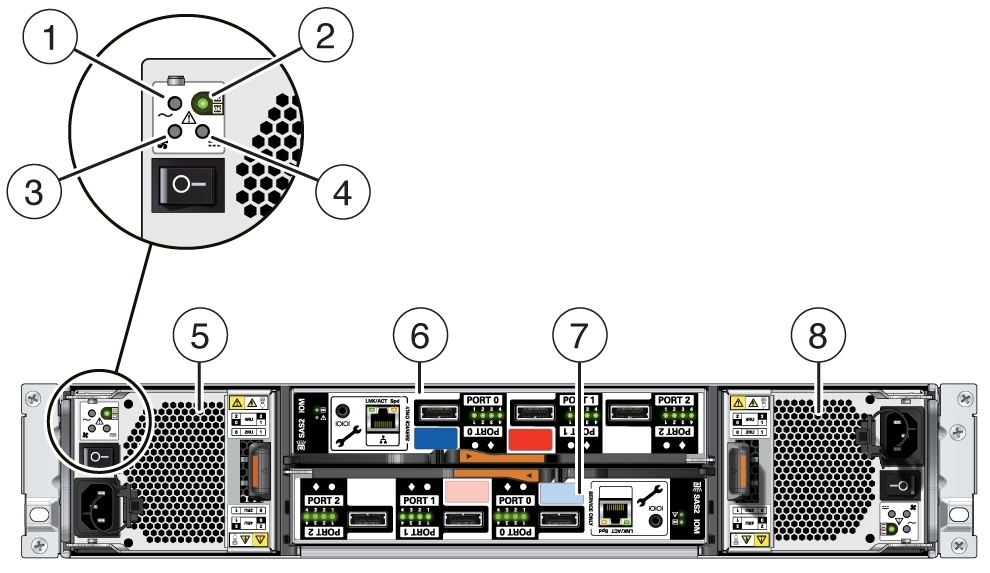
| Callout | Description |
|---|---|
|
1 |
AC power fail indicator |
|
2 |
Power supply status indicator |
|
3 |
Fan fail indicator |
|
4 |
DC power fail indicator |
|
5 |
Power Supply with Fan Module 0 |
|
6 |
SAS I/O module 1 |
|
7 |
SAS I/O module 0 |
|
8 |
Power Supply with Fan Module 1 |
Oracle Database Appliance (Original Version) Front and Back Panels
This section describes Oracle Database Appliance (original version) front and back panels. If you have Oracle Database Appliance X5-2, see Oracle Database Appliance X5-2 Front and Back Panels. If you have Oracle Database Appliance X3-2 or Oracle Database Appliance X4-2, see Oracle Database Appliance X3-2/X4-2 Front and Back Panels.
Oracle Database Appliance (Original Version) Front Panel
Oracle Database Appliance (original version) includes two server nodes, SN0 and SN1. SN0 is on the bottom and SN1 is on the top. Server nodes are also called system controllers.
The following figure shows Oracle Database Appliance front panel and describes its components.

Note:
The system has two each of items 1 through 8; one for each server node. It has only one RFID, product serial number tag, and, drive map.| Callout | Description |
|---|---|
|
1 |
Locate button/LED (white) |
|
2 |
SP (service processor) OK LED (green = OK, amber = fault) |
|
3 |
Server Node Ready to Remove LED (blue) |
|
4 |
Service Required LED (amber) |
|
5 |
Power/OK LED (green) |
|
6 |
System Over Temperature LED (amber) |
|
7 |
Rear HDD (hard disk drive)/PS (power supply)/Fan Fault LED (amber) |
|
8 |
Power button (recessed) |
|
9 |
Drive map |
|
10 |
RFID (radio frequency identification) and product serial number tag |
Oracle Database Appliance (Original Version) Back Panel
The following figure shows Oracle Database Appliance (original version) back panel and identifies the components on SN0. The components on SN1 are identical.
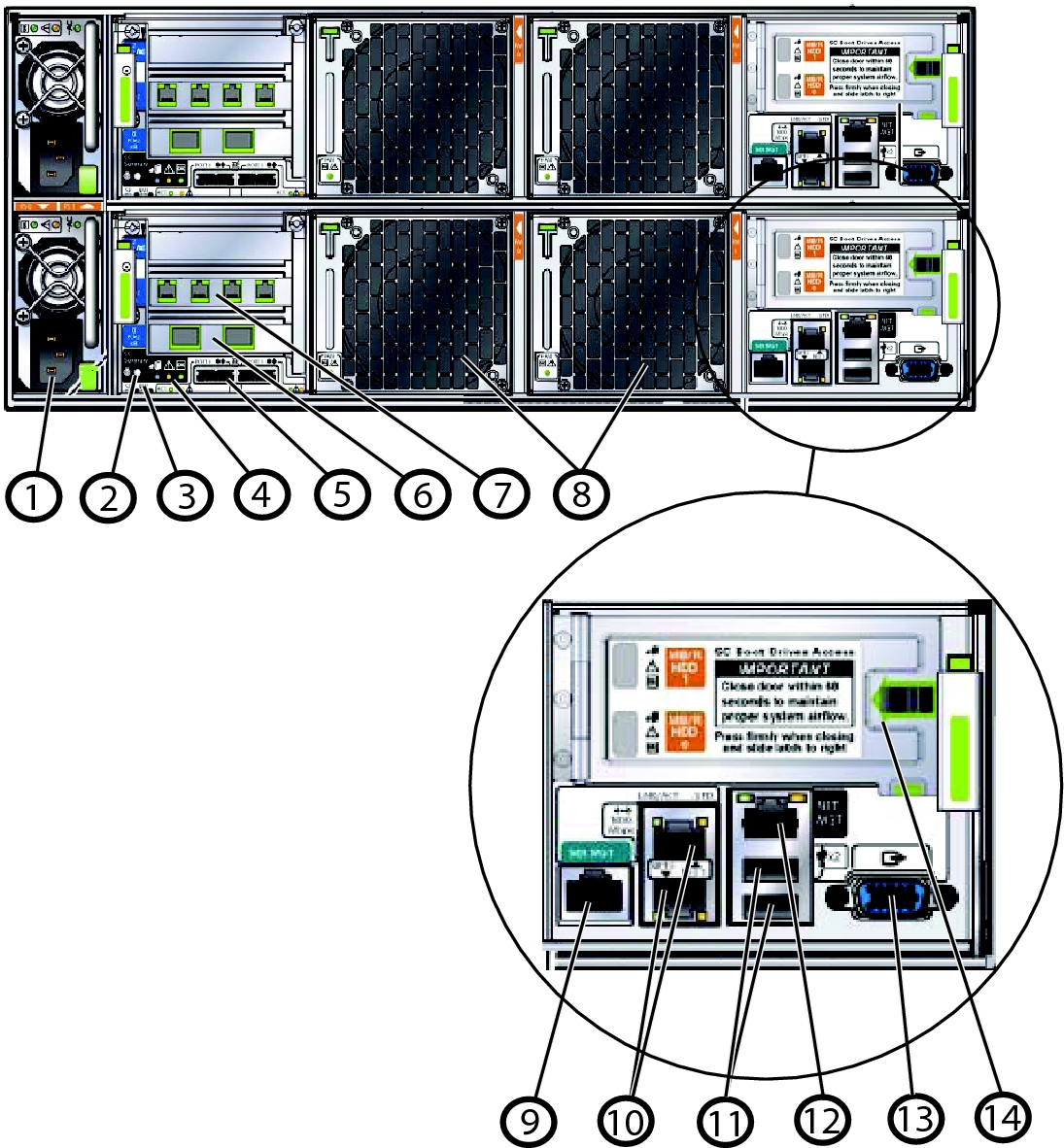
| Callout | Description | Callout | Description |
|---|---|---|---|
|
1 |
Power Supply Unit (PSU) |
8 |
Fans |
|
2 |
Locate button/LED (white) |
9 |
SER MGT port. Service processor RJ-45 serial port used to connect to Oracle ILOM
Caution -
The management ports are intended for use by service engineers only.
|
|
3 |
Host nonmaskable interrupt (NMI) and SP reset recessed switches |
10 |
Dual onboard 1 GbE network interface ports with RJ-45 connectors |
|
4 |
Status LEDs:
|
11 |
USB ports |
|
5 |
External MiniSAS ports (2 per server node) – Reserved. Do not use or connect cables to these ports |
12 |
NET MGT port. Service processor 10/100BASE-T network interface port with RJ-45 connector used to connect to Oracle Integrated Lights Out Manager (ILOM)
Caution -
The management ports are intended for use by service engineers only.
|
|
6 |
PCI Express (PCIe) slot 0 – Dual 10 GbE network interface ports |
13 |
Video connector to console |
|
7 |
PCIe slot 1 – Quad 1 GbE network interface ports with RJ-45 connectors |
14 |
Rear hard disk drives (RHDDs) (2 per server node)
Note - The RHDDs are behind hinged access panels. |
Oracle Database Appliance Specifications
This section describes the specifications for Oracle Database Appliance (original version) and Oracle Database Appliance X3-2 and X4-2.
Physical Specifications
This section describes the physical, electrical and Environmental specifications for the original Oracle Database Appliance.
The following table lists the physical specifications for Oracle Database Appliance.
| Item | ODA (Original Version) | ODA X3-2/X4-2 | ODA X5-2 |
|---|---|---|---|
|
Height |
175.1 mm (6.9 in) |
42.6 mm (1.7 in) per server node 87.9 mm (3.5 in) per storage shelf |
42.6 mm (1.7 in) per server node 175 mm (6.9 in) per storage shelf |
|
Width |
437 mm (17.2 in) (without mounting ears) 482.6 mm (19 in) (with mounting ears) |
Server node: 436.5 mm (17.2 in) Storage shelf: 483 mm (19 in) |
Server node: 436.5 mm (17.2 in) Storage shelf: 483 mm (19 in) |
|
Depth |
762 mm (30 in) 782 mm (30.8 in) (including fan module handles and latches) |
Server node: 737 mm (29 in) Storage shelf: 630 mm (24.8 in) |
Server node: 737 mm (29 in) Storage shelf: 630 mm (24.8 in) |
|
Weight |
72.6 kg (160 lbs) |
16.3 kg (36 lbs) per server node 24 kg (52.9 lbs) per storage shelf |
16.3 kg (36 lbs) per server node 37.2 kg (82 lbs) per storage shelf |
|
Acoustic noise |
7.8 B operating, 7.1 B idling (LwAd: 1 B=10 dB) |
7.9 B operating, 5.58 B idling (LwAd: 1 B=10 dB) |
7.0 Bels A-weighted operating, 7.0 Bels A-weighted idling |
Electrical Specifications
This section describes the electrical specifications for Oracle Database Appliance.
| Item | ODA (Original Version) | ODA X3-2/X4-2 | ODA X5-2 |
|---|---|---|---|
|
Server node power supply output rated maximum |
1270W at 100-120 VAC 1370W at 200-240 VAC |
600W at 100-127 VAC 600W at 200-240 VAC |
600W at 100-127 VAC 600W at 200-240 VAC |
|
Server node AC power |
12A at 110-127 VAC 7A at 200-240 VAC 13A at 100 VAC (Japan only) |
7.2A at 100-127 VAC 3.4A at 200-240 VAC |
7.2A at 100-127 VAC 3.4A at 200-240 VAC |
|
Storage shelf power supply output rated maximum |
Not supported |
580W at 100-127 VAC 580W at 200-240 VAC |
580W at 100-127 VAC 580W at 200-240 VAC |
|
Storage shelf AC Power |
Not supported |
8A at 100-127 VAC 3A at 220-240 VAC |
8A at 100-127 VAC 3A at 220-240 VAC |
|
Power usage |
Not available |
Not available |
Server node
Storage shelf
|
Environmental Specifications
This section describes the environmental specifications for a single, non-racked Oracle Database Appliance.
| Item | ODA (Original Version) | ODA X3-2/X4-2 | ODA X5-2 |
|---|---|---|---|
|
Operating temperature |
5° C to 35° C
(41° F to 95° F).
|
5° C to 35° C
(41° F to 95° F)
|
5° C to 35° C
(41° F to 95° F)
|
|
Nonoperating temperature |
-40° C to 70° C
(-40° F to 158° F).
|
-40° C to 70° C
(-40° F to 158° F)
|
-40° C to 70° C
(-40° F to 158° F)
|
|
Operating humidity |
10% to 90% relative humidity, noncondensing |
10% to 90% relative humidity, noncondensing |
10% to 90% relative humidity, noncondensing |
|
Nonoperating humidity |
Up to 93% relative humidity, noncondensing. |
Up to 93% relative humidity, non-condensing |
Up to 93% relative humidity, non-condensing |
|
Operating altitude |
Up to 3000 m* (9,840 ft). Maximum ambient temperature is derated by 1
oC per 300 m (984 ft) above 900 m (2,953 ft)
* Except in China markets where regulations might limit installations to a maximum altitude of 2,000 m (6562 ft). |
Up to 3,048 m* (10,000 ft); maximum ambient temperature is derated by 1° C per 300 m above 900 m * Except in China where regulations might limit installations to a maximum altitude of 2,000 m (6562 ft). |
Up to 3,048 m* (10,000 ft); maximum ambient temperature is derated by 1° C per 300 m above 900 m * Except in China where regulations might limit installations to a maximum altitude of 2,000 m (6562 ft). |
|
Nonoperating altitude |
Up to 12,000 m (39,370 ft) |
Up to 12,000 m (39,370 ft) |
Up to 12,000 m (39,370 ft) |
|
Cooling |
Not available |
Not available |
Server node
Storage shelf
|
Technical Support
When requesting technical support, report the following to Oracle Support Services:
| ODA (Original Version) | ODA X3-2/X4-2/X5-2 |
|---|---|
|
For the original Oracle Database Appliance, report the serial number located on the front panel of the system and on the Customer Information Sheet that is shipped with the system. |
For Oracle Database Appliance X3-2, Oracle Database Appliance X4-2, and Oracle Database Appliance X5-2, report the Top Level Identifier (TLI). To see the TLI, look on the Customer Information Sheet, or look at the top of a server node or a storage shelf, on the left-hand side towards the front. The TLI part number and TLI serial number are the same for all factory-bundled components of an appliance. For example: 
If the appliance is in a rack where you cannot see the TLI, do one of the following:
|